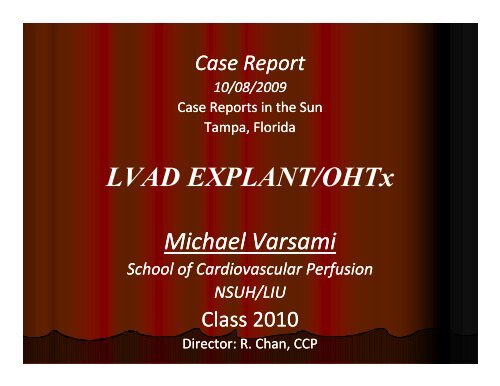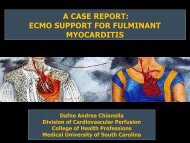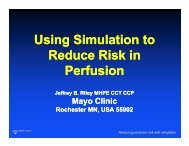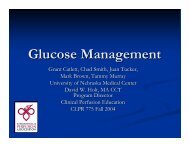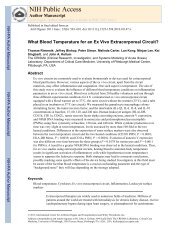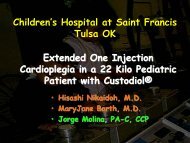PowerPoint Presentation (PDF) - Perfusion.com
PowerPoint Presentation (PDF) - Perfusion.com
PowerPoint Presentation (PDF) - Perfusion.com
Create successful ePaper yourself
Turn your PDF publications into a flip-book with our unique Google optimized e-Paper software.
Case Report<br />
10/08/2009<br />
Case Reports in the Sun<br />
Tampa, Florida<br />
LVAD EXPLANT/OHTx<br />
Michael Varsami<br />
Sh School of Cardiovascular <strong>Perfusion</strong><br />
NSUH/LIU<br />
Class 2010<br />
Director: R. Chan, CCP
• Date: 03/31/2009<br />
• Procedure: LVAD Explant/OHTx<br />
• Heart transported on TransMedics OCS<br />
• Rotation: New York Presbyterian‐Columbia<br />
• Pt’s Age: 24 y/o<br />
• Gender: Male<br />
• Case # 23‐2<br />
• <strong>Perfusion</strong>ists: sts: M.Brewer,CCP e / N. Edson,CCP,<br />
,<br />
C, Farrell, CCP<br />
• <strong>Perfusion</strong> Student: M. Varsami
Heart Failure<br />
• 5 million people<br />
• Class III or IV (New York Heart)<br />
• 50,000 000 potential ti therapy pool<br />
• ~2000 receive Tx<br />
• 48,000 dependant on the reimbursement<br />
of new devices<br />
• Dependent on <strong>Perfusion</strong> and H/L machines
Patient’s Information<br />
• History of present illness:<br />
• 24 y/o male,<br />
• Hx of CHF (EF 15%) from viral DCM on 11/07 (home<br />
on Milrinone)<br />
• S/p PPM/AICD 12/07<br />
• LVAD (HEARTMATE I) placement on 2/1/2009<br />
• Admitted on 3/6/09 with device malfunction (device<br />
was checked)<br />
• Status 1A<br />
• Participant in the Transmedics study & the heart was<br />
transported on the transmedics device.
TransMedics edcs OCS<br />
(Organ Care System)<br />
1 st case @ Columbia Un. Hospital<br />
Organ care system<br />
<strong>Perfusion</strong> module<br />
Priming solution
TransMedics OCS<br />
(Organ Care System)<br />
‣ NOT FDA approved. Still on trials.<br />
‣ Recipient must consent for harvest with TransMedics<br />
OCS<br />
‣ Maintains organ at a near physiologic functioning state<br />
‣ Increasing organs availability<br />
‣ Tremendous reduction of cold ischemic time<br />
‣ Better post operation out<strong>com</strong>es<br />
‣ Easily transportable. Transportation time up to 6‐8 hrs
OCS<br />
• Portable platform<br />
insures the<br />
appropriate<br />
environment for the<br />
organ. Optimizes<br />
perfusion of warm,<br />
oxygenated nutrient<br />
rich blood.
TransMedics OCS<br />
Monitoring<br />
Aortic Pressure<br />
HR<br />
AF (Aortic Flow)<br />
CF (Coronary Flow)<br />
Spo2<br />
Oxygenator/<br />
Blood pump<br />
Hct<br />
Blood Temp.
TransMedics/ <strong>Perfusion</strong> Module<br />
LA/Ao & cardioplegia access points<br />
Flow control<br />
Resting/working mode<br />
<strong>Perfusion</strong> module<br />
Defibrillation pads<br />
Sampling mannifold<br />
PA outlet
TransMedics/ <strong>Perfusion</strong> Module<br />
Visual, functional & metabolic assessments of the organ
Priming Solution<br />
500 mL<br />
Mannitol 12.5g<br />
NaCl 4.8g<br />
KCl 0.185g<br />
Magnesium Sulfate 0.185g<br />
Sodium Glycerophosphate 0.90g<br />
Water for injection 500mL<br />
pH 7.3‐7.6<br />
7.6<br />
Added Medications:<br />
Multivitamin (1 Unit)<br />
HCO3 (20 meq)<br />
Solumedrol (250 mg)
Priming Solution<br />
1. Transmedics Maintenance Infusion (TMI)<br />
Volume: 500 mL<br />
Initial Rate: 10 mL/hr<br />
Adenosine 750 mg<br />
Calcium Chloride Dihydrate 2400 mg<br />
Magnesium Sulfate Heptahydrate 400 mg<br />
Potassium Chloride 20 mg<br />
NCl750<br />
NaCl mg<br />
Amino Acids:<br />
Glycine 350 mg<br />
L‐alanine 174 mg<br />
L‐arginine 700 mg<br />
Aspartic Acid 245 mg<br />
L‐Glutamic Acid 258 mg<br />
L‐Histidine 225 mg<br />
L‐Isoleucine 115.5 mg<br />
L‐Leucine Leucine 343 mg<br />
L‐Methionine 59 mg<br />
L‐Phenylalanine 52 mg<br />
L‐Proline 126 mg<br />
L‐Serine 93 mg<br />
L‐Threonine 92 mg<br />
L‐Valine 171.5 mg<br />
Lysine Acetate 225 mg<br />
2. Epinephrine Drip<br />
Volume 500 mL<br />
Initial Rate: 5 mL/hr<br />
0.25 mg Epinephrine in 500 mL of D5W<br />
30 Units of Insulin
TransMedics OCS/schematic diagram<br />
LA port<br />
Cardioplegia port<br />
Loading mode<br />
Pump<br />
Working mode<br />
PA cannula<br />
Aorta<br />
Reservoir<br />
Oxygenator/HE<br />
(QUADROX D)<br />
PA cannula outlet
TransMedics OCS<br />
Two modes:<br />
Working mode<br />
Resting mode<br />
‣ Unloaded- Resting mode (Retrograde<br />
fashion)<br />
PA → OCS → Ao → CA → CS → RA → PA<br />
‣Loaded- Working mode (Antegrade fashion)<br />
PA → OCS → LA → LV → Ao → CA → CS → RA → PA
Equipments<br />
• Synthesis Hard Shell Venous Reservoir<br />
(open)<br />
‐ Max cardiotomy flow rate 4LPM<br />
‐ Max reservoir volume 4300 ml<br />
‐ Min reservoir volume 300 ml<br />
‐ integral pressure valve +5.3/‐175<br />
mmHg<br />
‐ 1 screen(40μm) & 2 depths filters<br />
‐ Connections: venous return ½”,<br />
venous reservoir outlet‐oxyg. oxyg. Inlet‐<br />
arterial outlet 3/8”.
Equipments (continue)<br />
Membrane oxygenator:<br />
‐ Max BQ rate 8LPM<br />
‐ polypropylene, non porous material<br />
‐ surface area 2.0 m 2<br />
‐ H/E surface area 0.14 m 2<br />
Arterial filter<br />
‐ polyester screen filter 40 μm<br />
‐ effective surface area 400 cm<br />
2<br />
Priming volume (oxygenator, H/E, AF)<br />
500 ml
Equipments (continue)<br />
• Capdioplegia: QMPS2, Quest Medical<br />
• Centrifugal Pump: Maquet Rotaflow<br />
• Console: Maquet tJ Jostra HL20
Additional Equipments<br />
• Cell Saver: Brat‐2<br />
• Gas Filter:Gish<br />
Biomedical 0.2µm<br />
• Heater Cooler: Maquet<br />
Jostra HCU30<br />
• Transfusion Filter: Pll<br />
Pall<br />
SQ40S 40µm<br />
• Venous SAT/HCT<br />
Monitor(influent<br />
spectophotometry)
Patient’s Information<br />
PMH<br />
‐ NIDCM<br />
‐ DM Dx 11/07<br />
‐ H/O LV thrombus (on coumadin)<br />
PSH<br />
‐ PPM/AICD 12/07<br />
‐ LVAD (Heartmate I) 2/1/09<br />
HOME/IN PT MEDS:<br />
‐ ASA 81mg<br />
‐ Enalapril 15mg<br />
‐ Carvedilol 25mg<br />
‐ Milrinone
Thoratec Heartmate LVAD
Patient’s Information<br />
PPM/AICD<br />
LVAD outflow<br />
LVAD inflow
Patient’s Information
• Allergies<br />
NKDA<br />
…Patient’s Information<br />
• Pre‐op labs<br />
Na 139meq/L, K 4.5 meq, Glu 97mg/dL, Pl<br />
184.000, Hgb/Hct 16/44 %,<br />
PT/PTT/INR 14.1/31.3/1.05
Donors Information<br />
• 24 Y/o male, died on car accident<br />
(Buffalo)<br />
• Harvest team assembled and sent for<br />
organs.<br />
• Recipient consented for harvest with<br />
TransMedics module.
Prime/Meds<br />
<br />
1L RL, 1 L Hextend<br />
12.5 gr Mannitol, 50mEq NaHCO 3 , 4,000 units<br />
heparin<br />
Clear Prime Replacement 400ml<br />
(Immediate initiation of CPB )
Calculations<br />
• BSA 2.0m 2 (Wt 80kg, Ht 180cm)<br />
• BQ ‐ 48LPM 4.8 @ 24CI<br />
2.4 ‐ 4.4 LPM @ 2.2 CI<br />
‐ 4.0 LPM @<br />
2.0 CI<br />
• CDHct 31% (pre pump Hct 40%)<br />
• Initial Heparin 24,000 units (300mg/kg)
Pre CPB…<br />
‣ 300pm 3:00 pm. Pt came walking in the OR, & connected with<br />
the Heartmate I console.
Pre CPB…<br />
‣ Arterial line was placed & pt was anesthetized<br />
& intubated (8.0 tube, 24 cm endotracheal<br />
tube)<br />
‣ Sedation was achieved with administration of:<br />
‐ Propofol, 14mg/ml<br />
‐ Fentanyl, 100mcg/ml<br />
‐ Rocuronium, 1mg/ml ‐ Isoflurane 0.5%<br />
‣ Swan ganz catheter was placed<br />
‣ Baseline ACT 144 sec, Pre‐pump Hct 38%.
Pre CPB…<br />
‣ Pre‐op TEE:<br />
EF 25‐35 %, RWMA present, LVAD inflow at<br />
apex/LVAD outflow at asc. aorta, hypokinetic<br />
septum/anterior wall, mildly decreased RV<br />
function, dilated RV, Trace AI,MR,TR,PR
Pre CPB……<br />
‣ Median sternotomy was performed.<br />
LVAD<br />
Pt’s head
Pre CPB……
Going ON CPB…<br />
‣ 24,000 units Heparin was given/Act 573sec.Aorta was<br />
cannulated (7.0mm/21 fr, SF)<br />
‣ 100‐150cc 150cc test dose (line pressure /LPM<br />
appropriate).<strong>Perfusion</strong> team ready for CPB initiation.<br />
‣ SVC cannulated (24 Rt)<br />
‣ Clear prime was taken,400ml. (Usually 1000‐1200 1200 cc)<br />
‣ 17:24 Immediate initiation of CPB ( SVC cannula). Pt was<br />
disconnected d from Heartmate t I. Forane ON.<br />
‣ <strong>Perfusion</strong> initiation check list <strong>com</strong>pleted.<br />
‣ Pt cooled to 32 0 C, IVC cannula in (28 rt).<br />
‣ 17:56 Xcl ON<br />
‣ 18:08 OFF CPB ( IVC cannula came out)<br />
‣ 18:09 ON CPB (IVC cannula re‐placed)
On CPB…<br />
‣ Harvest team in OR. Heart on Transmedics OCS. Video #2/#3<br />
‣ IVC/SVC snared. No change in drainage/Pt’s head checked.<br />
‣ LVAD/Heart were explanted
video 2<br />
Transmedics OCS
Video 2<br />
Transmedics OCS
Explanted heart/LV apex<br />
LV outflow/HM I inflow
Explanted LVAD<br />
(Thoratec heartmate I)<br />
Apex → LVAD inflow<br />
Asc. Aorta ← LVAD outflow<br />
to HM console
Pts heart explanted/IVC/SVC snared<br />
IVC<br />
Aortic Xclamp<br />
SVC
ON CPB…<br />
<br />
ATH cardioplegia/adenosine i d i (maitenance solution) were given to the<br />
donor’s heart through Transmedics devise & the heart was disconnected from<br />
Transmedics Organ Care System. Video #4
ON CPB…<br />
ATH cardioplegia/adenosine (maitenance solution) were given to the<br />
donor’s heart through Transmedics devise & the heart was disconnected from<br />
Transmedics Organ Care System. Video #4<br />
<br />
LA anastomosis was performed<br />
PA/Ao anastomoses were performed<br />
18:38 Pt rewarmed to 37 0 C<br />
18:51 Lidocaine 200mg, Ao XCL OFF (55 min), Ischemic time 68min<br />
IVC/SVC anastomoses were performed.
PA Anastomosis<br />
Ao root vent<br />
Asc. Aorta<br />
PA anastomosis<br />
Aortic Xclamp
IVC Anastomosis<br />
LV vent
Weaning from CPB…<br />
‣ Difficulty weaning OFF CPB. Pt on Milrinone 0.5<br />
mcg/kg/min then Dobutamine 5 mcg/kg/min. RV &<br />
inferior LV hypokinetic.<br />
‣ Pt rested ON CPB x 30min. LV contractility improved, but<br />
RV was still hypokinetic. During arresting time iNO @<br />
20PPM started, & IABP was placed 1:2<br />
‣ Pt weaning successfully OFF CPB.<br />
‣ Chest packed & left open.
Post CPB…<br />
‣ Post‐op op TEE:<br />
EF 35‐44%, RWMA present, inferior & apical hypokinesis, normal RV<br />
size & function, Trace MR, TR, PR, IABP present. (pt on Dobutamine<br />
5 mcg/kg/min, and Milrinone 0.5 mcg/kg/min, iNO 20 PPM).<br />
‣ Post pump ABGs:<br />
‣ pH 7.39, pCO2 38, pO 2 590, Na 139, K 3.8, Glu 93, Hgb/Hct<br />
7/20, Ca 1.22,<br />
‣ Post pump ACT 114sec (baseline 144sec)
Drugs ON CPB…<br />
‣ 80 mcg/cc of Neosynephrine, If MAP < 60 mmHg<br />
‣ Milrinone 2mg<br />
‣ Fentanyl (350mcg)<br />
‣ Vecuronium (10 mg)<br />
‣ Versed (13 mg)<br />
‣ Heparin (16,000Units)<br />
‣ Insulin ( 4 units)<br />
‣ Lidocaine (200 mg)
Final Measurements/Comments<br />
<br />
<br />
<br />
<br />
<br />
CPB Time: 3hr 48min,<br />
XCL Time: 55min,<br />
Ischemic c Time: 1hr 8min (28+40min)<br />
Total Heparin/Protamine 44,000 units/250mg (Hepcon<br />
analysis)<br />
Fluid Balance +1140 cc
Final Measurements/Comments<br />
Pump urine 100ml<br />
FFP 6units<br />
Cell saver 1000ml (4 units)<br />
Platelets 12 units<br />
RBC’s 5 Units<br />
Cryoprecipitate 10 Units
CTICU<br />
‣ Pt arrived @<br />
CTICU intubated & on ventilator support.<br />
Sedated on Propofol 40mcg/kg/min, & on Levophen<br />
3mcg/kg/min, Dobutamine 5mcg/kg/min, Milrinone 0.5<br />
mcg/kg/min, iNO 20PPM, IABP 1:2.<br />
‣ Physical exam: HR 112 ABP 74/46, PAP 16/8, CVP 5,<br />
‣ Vent: Vt 600ml, PEEP 5, FiO2 100%.
POD # 1<br />
Pt returned to OR & chest was closed. iNO & IAPB<br />
were maintained.<br />
POD # 2<br />
Pt was extubated & dissconnected from IABP/iNO<br />
in CTICU.
Concluding…OCS<br />
‣ Maintains organ at a near physiologic functioning state<br />
‣ Increasing organs availability by Increasing the amount of time that an<br />
organ can be maintained outside the body in a condition suitable for<br />
transplantation by reducing time dependent ischemic injury<br />
‣ Tremendous reduction of cold ischemic time.(in our case 1hr 8 min)<br />
‣ Better post operation out<strong>com</strong>es (theoretically)<br />
‣ Easily transportable<br />
‣ Provide surgeons the opportunity to assess the function of the organ<br />
outside the body (loading mode)<br />
‣ Enable resuscitation of the organ and potentially improve function after<br />
removal from donor
•Quand on ne sait pas, on a<br />
peur<br />
•When you don’t know, you<br />
are afraid<br />
Eric cCantona<br />
a<br />
•In my opinion…<br />
PERFUSION=KNOWLEDGE<br />
M. Varsami
Smile more often !!!!!
THANK YOU…


